List of Authors
>>About this blog
Recent blog post
|
[JRT Felt]
Nov. 30, 2016 16:00
While walking near Royal Park, I found an unfamiliar sign!
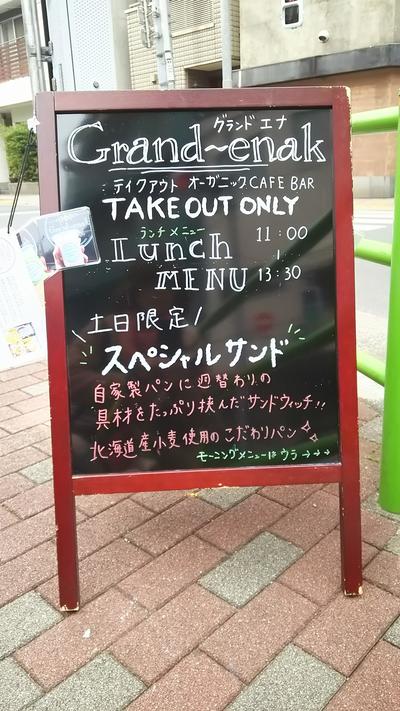
If you look closely, you can see that there is a stylish cafe nearby. I went to check it out right away.
It is a take-out cafe bar mainly composed of organic food, and the name of the shop is.
"Grand-enak" (Grand Ena). It seems that it was OPEN on October 1, 2016.
There are homemade sandwiches made with bread from the long-established "Pelican" in Asakusa.

Salads made with fresh vegetables sent directly from the production area, green smoothies,

Eggs, butter, macrobiotic muffins that do not use any white sugar, etc.
The products are carefully handcrafted one by one.
It's not only delicious, but also good for your body! It's a very nice shop.

Beans of Seichiro Coffee (the store in front of Suitengu was closed in July this year)
It seems that there is also a coffee using it and a lunch box only on weekdays.
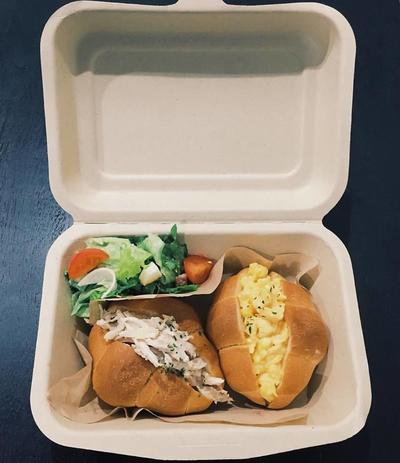
It is located close to Suitengu and Royal Park Hotel.
When you come near you!
Photos (second and subsequent photos) were reprinted from facebook with permission from the shop.
**********************************
≪Store name: Grand-enak (Grand Ena)
≪Location: 2-8-7, Nihonbashi Kakigaracho, Chuo-ku Taguchi Building 1F
≪Business≫ Weekdays 8: 30-13: 30, weekends and holidays 9: 30-13: 30
≪Telephone≫ 070-1271-1177 ※Telephone reservation available
https://www.facebook.com/Grand-enak-1070179083074509/
[O'age]
Nov. 30, 2016 14:00
While walking along Shin-ohashi-dori St., I saw the display of "Tokanbori-dori", so at a later date, look for the display of the old moat traces. I managed to find an explanation board for "Inaribori Ruins". There was also an explanation board for "Gyotoku Riverside" nearby. It is not listed in the Monoshiri Encyclopedia, so I will introduce it in the following photo.
Tokanbori Street
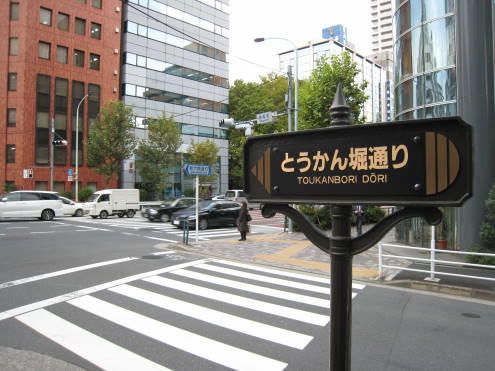
Explanation board (Chuo-ku Board of Education) of the ruins of Inaribori (Tokanbori)

Gyotoku Riverside (Chuo-ku Board of Education)
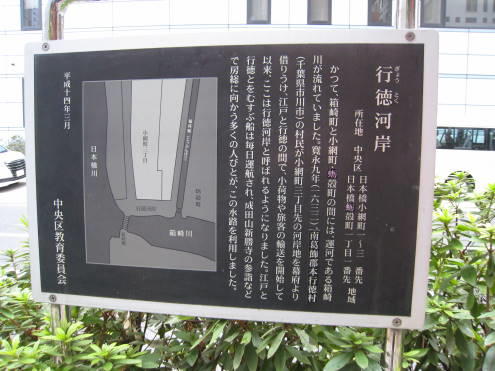
Looking up at the highway above this area, I remember the days when I checked in nearby and went to Narita Airport by bus several decades ago. Hiroshige draws this area with "Mitsumata Wakare no Fuchi".
In addition, there is an explanation board near (northwest direction), "Maison Konosu Founding Land". Compared to the cafe "Maison Konosu" (published on Monoshiri Encyclopedia p26), here it is described as "Western restaurants that also serve as bars". It seems that many famous writers have gathered.

[Asunaro]
Nov. 29, 2016 09:00

Mimizuku at Koami Shrine is named after the Doburoku Festival (Niiname-no-Matsuri) and the New Year.
It is made from Susukiki, one of the seven herbs in autumn.
The benefit is “going” to “mi (body)” and the family “mi (body)”.
It will be awarded for that.

I was caught by the Chinese zodiac sign next year.
By the way, what is the difference between "Mizuku" and "owl"?
I found that both are the same type of owl and owl.
It seems common to call those who have ears (Hasumi) as earthworms.
"Mizuku in the downtown area" also has a strong ears.
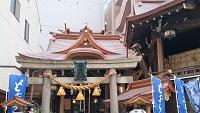
◆Koami Shrine
16-23, Nihonbashikoamicho, Chuo-ku, Tokyo
[Nojinya]
Nov. 26, 2016 16:00
Hello! What do you think of when you hear "Kiha"? 。 。 。 The person who immediately answered, "It's a diesel car!" 。 。 It's a good answer!
When I hear "Kiha", I remember Jiro Asada's short novel "Poppiya (Shueisha Bunko)".
"When you leave the platform at Miyoro Station, Horomai's single line runs alongside the main line for a while before passing through the streets. The glass-walled resort limited express passes through the Kiha 12-type railcar slowly as if you were looking at it. Whether it's a mischief of the diamond or a production prepared for the urban skier, the train windows of the limited express are bells, watching the vermilion Japan National Railways. 。 。 <Omitted>. 。 。 Kiha 12, which departs at 18:35, is the last of Horomai, which runs only three times a day. "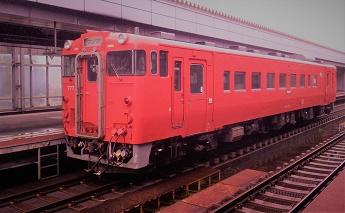
[Nemuro Main Line Kiha 40 bound for Takigawa, which is stopped at Obihiro Station]
"Railroad worker" is a story that develops as the main character of the local line station manager Otomatsu Sato (Ken Takakura), just before the abandoned line in Hokkaido. It was made into a movie in 1999, but at that time, location was being performed at Ikutora Station on the Nemuro Main Line in Minamifurano-cho (Note: Nemuro Main Line was typhoon No. 10 on August 30, this year. It is said that restoration is difficult due to the damage caused by the damage, partly due to the business situation of JR Hokkaido). In commemoration of the movie adaptation, Ikutora Station preserves the top part of Kiha 12, which was modified from Kiha 40. preserves the top part of Kiha 12, which was modified from Kiha 40.
Here is a mini commentary, "Kiha" is a type symbol of JR vehicles. "Ki" refers to a diesel car (railcar) as it is, and "C" refers to an ordinary car, and "Kiha" refers to an ordinary car of a diesel car. Some of the similar ones are "Moha", but "Mo" is a train vehicle (electric vehicle) with a motor and refers to a regular train car. Instead of "c", "c", "shi" or "ne" may enter, but "kilo" is a green car of a diesel car, a dining car if "shi" is entered to a diesel car (railcar) as it is, and "C" refers to an ordinary car, and "Kiha" refers to an ordinary car of a diesel car. Some of the similar ones are "Moha", but "Mo" is a train vehicle (electric vehicle) with a motor and refers to a regular train car. Instead of "c", "c", "shi" or "ne" may enter, but "kilo" is a green car of a diesel car, a dining car if "shi" is entered , and "ne" is a sleeping car . , and "ne" is a sleeping car .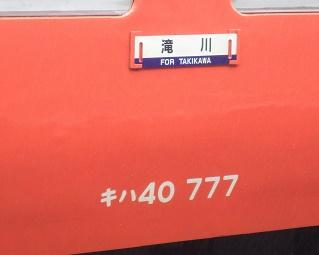
。 。 。 The preface has become longer, but it's time to go to the main subject.
This time, I was a boy who was a railway kid, and a friend with a strong iron told me, "Let's go for drinking !" After work, join at Ningyocho Station and walk for about 5 minutes in the direction of Horidome-cho, where the success Inari is located. Then, in the dark, you will see a common "Noriba" guide at the station. !" After work, join at Ningyocho Station and walk for about 5 minutes in the direction of Horidome-cho, where the success Inari is located. Then, in the dark, you will see a common "Noriba" guide at the station.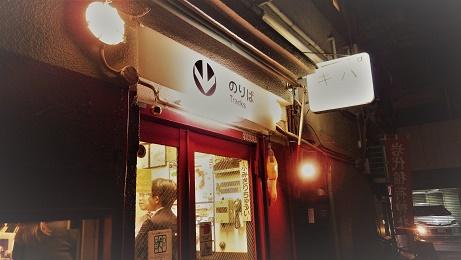
When you open the door unintentionally and enter inside, you will receive a voice of an assistant (master) saying "Thank you for your ride!" There is a yellow information board on the left of the entrance, which is like a subway station yard exit, a transfer to the Hibiya Line, Asakusa Line 2 (although it is actually on the second floor). If you go to the back of the store, you will find a buffet car on the limited express train (Is it a "Kiha" cafeteria car?) A few customers are already enjoying beer  and cooking at the counter like in the above. On the counter, canned food of this store is piled up high, and when ordered by an assistant, it cooks one by one and serves as a snack. First of all, while drinking a toast beer and cooking at the counter like in the above. On the counter, canned food of this store is piled up high, and when ordered by an assistant, it cooks one by one and serves as a snack. First of all, while drinking a toast beer , I decided to have an oil serdin selected by a friend. , I decided to have an oil serdin selected by a friend. 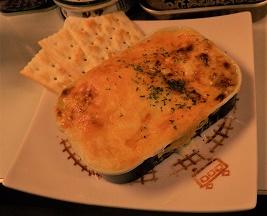 It's quite delicious It's quite delicious because it's stupid with canned food! 。 。 。 And the second cup is a one-cup liquor because it's stupid with canned food! 。 。 。 And the second cup is a one-cup liquor that is indispensable for railway trips. The locally brewed sake Cup in Niigata (Gosen City), where the picture of SL (C57) is drawn! that is indispensable for railway trips. The locally brewed sake Cup in Niigata (Gosen City), where the picture of SL (C57) is drawn! 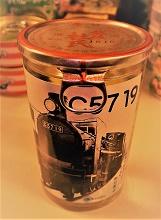 When drinking while saying "It's delicious" with a friend, the customer who was in the back is the manufacturer of the One Cup sake (Kinshihai Sake Brewery) http://www.kinshihai.com/index.html) ) With the president. Today, he was on a business trip to Tokyo, and he stopped by this shop that wholesales sake and also served as a greeting. I feel like traveling with unexpected encounters! When drinking while saying "It's delicious" with a friend, the customer who was in the back is the manufacturer of the One Cup sake (Kinshihai Sake Brewery) http://www.kinshihai.com/index.html) ) With the president. Today, he was on a business trip to Tokyo, and he stopped by this shop that wholesales sake and also served as a greeting. I feel like traveling with unexpected encounters!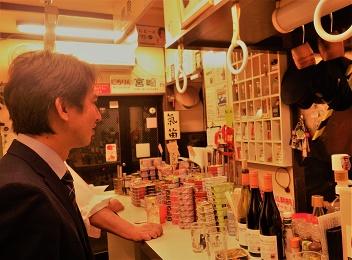
There is a strap that can be grabbed on the counter even if you get drunk, and on the second floor you can sit on a long train seat and drink. It was a standing drink, so I wanted to go in a little bit, but after all, I stayed for about two and a half hours in the delicious food, alcohol, and the fun atmosphere of the shop.
[Kiha, the last station for alcohol and railway lovers]
Location 1-6-11, Nihonbashi-Horidomecho, Chuo-ku, 103-0012, Japan
Phone: 03‐5651‐5088
Business hours From 18:00 to 23:30 (Open on Sundays and holidays, irregular operation (open) on Saturday, so check in advance)
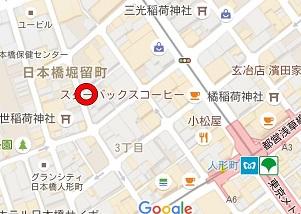
[Silver]
Nov. 26, 2016 12:00
Huffman and Jeffrey, who are teaching English at St. Luke's International University, participated in a seminar titled "Let's Develop a Global Self" on November 17.
Under the theme of learning English, he taught me the motivation, reason, and efficacy of learning English. Why do we learn English? learning English, he taught me the motivation, reason, and efficacy of learning English. Why do we learn English?
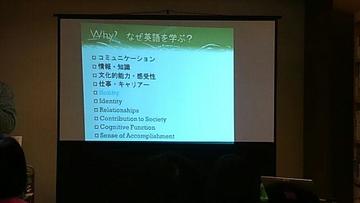
1)Communication, 2) Acquisition of information and knowledge, 3) To enhance cultural skills and sensitivity, 4) to improve work and career.
5)For my hobbies, I taught me that there are various things such as 6) Identity, 7) Relationships, 8) Contribution to Society, 9) Cognitive Function, and 10) Sence of Accomplishment.
9)In the explanation of the Cognitive Functions, the Company explained
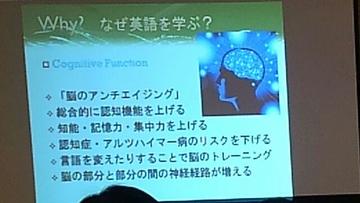
"Anti-aging of the brain", "Improve cognitive ability comprehensively", "Improve intelligence, memory, and concentration", "Improve the risk of dementia and Alzheimer's disease", "By changing language, I learned that it is effective for training  and increasing the neural path between the brain and part. It's just a good thing and increasing the neural path between the brain and part. It's just a good thing . .
By all means, I would like to brush up my English and entertain visitors.
It was a very useful lecture.
Thank you very much.
[Silver]
Nov. 26, 2016 12:00
This year, the "Gathering of International Exchange" by the Chuo-ku Cultural and International Exchange Promotion Association was held on Saturday, November 19 at Tsukiji Education Center. .
First of all, we finished the reception on the first floor and headed to the cooking class on the 4th floor.
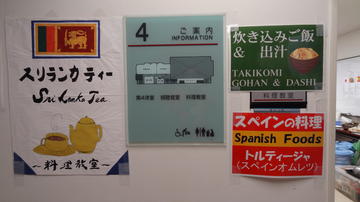
Spanish omelet, cooked rice, and clear bonito soup stock.
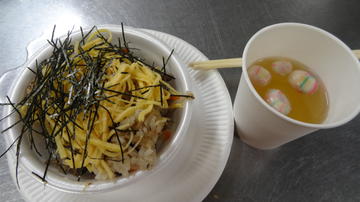
After the meal, Sri Lankan milk tea was very delicious. People from foreign countries were also smiling.
On the second floor, hula dance.
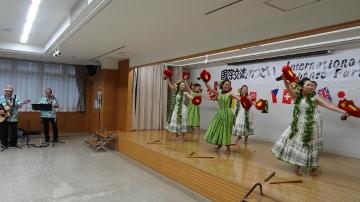
Continuing from last year, a flamenco show by Tomoko Ishii flamenco Studios.
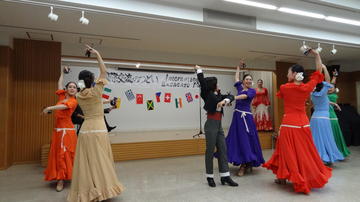
And I was taught a beginner flamenco for our beginners. Ole' 
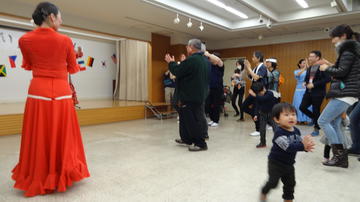
I participated in this year's "Marugoto Museum" and conveyed the wonderfulness of flamenco to the general public. It is said that 70-year-old and 80-year-olds also attend lessons at the great studio. How about you? I'll try it too. Click here for the website of the studio. http://www.tomokoishii.com/ studio. How about you? I'll try it too. Click here for the website of the studio. http://www.tomokoishii.com/
And Bon festival dance by people from Chuo-ku. Everyone was dancing happily to songs such as "This is the Bon Dance in Edo".
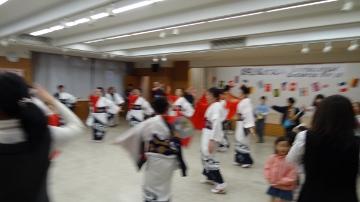
On the same second floor, there was an introduction corner of the sister city of Australia, and everyone was learning with interest.
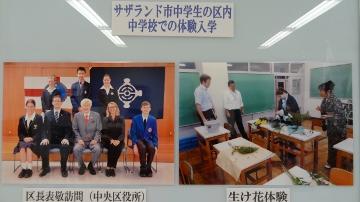
In addition, there was a corner for playing in Japan where children could enjoy, and laughter was echoing with lucky laughter, quoits, daruma drops, beanbags, etc.
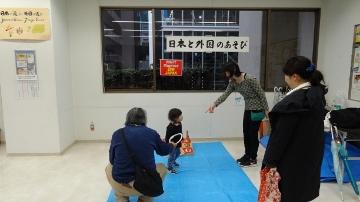
On the 3rd floor, there is a dressing class for foreigners, ikebana experience, and so on.
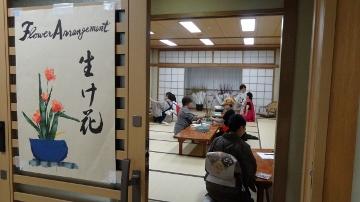
Tea ceremony and tea ceremony experience, ink painting, origami, and furoshiki classes were offered.
On the first floor, wadaiko performances were held, and foreigners also played a flute and explained the music in English.
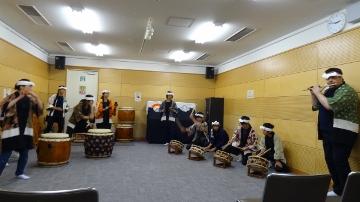
I realized that deep international exchange is taking place.
At the disaster prevention corner on the 4th floor, there were emergency food tasting corners in the event of a disaster and maps about evacuation site, which were also appreciated by foreigners living in Chuo-ku.
I would like to express my deep appreciation and respect to the Chuo-ku Cultural and International Exchange Promotion Association, which is held every year. Thank you very much.
|
Links
|











 It's quite delicious
It's quite delicious When drinking while saying "It's delicious" with a friend, the customer who was in the back is the manufacturer of the One Cup sake (Kinshihai Sake Brewery)
When drinking while saying "It's delicious" with a friend, the customer who was in the back is the manufacturer of the One Cup sake (Kinshihai Sake Brewery) 













